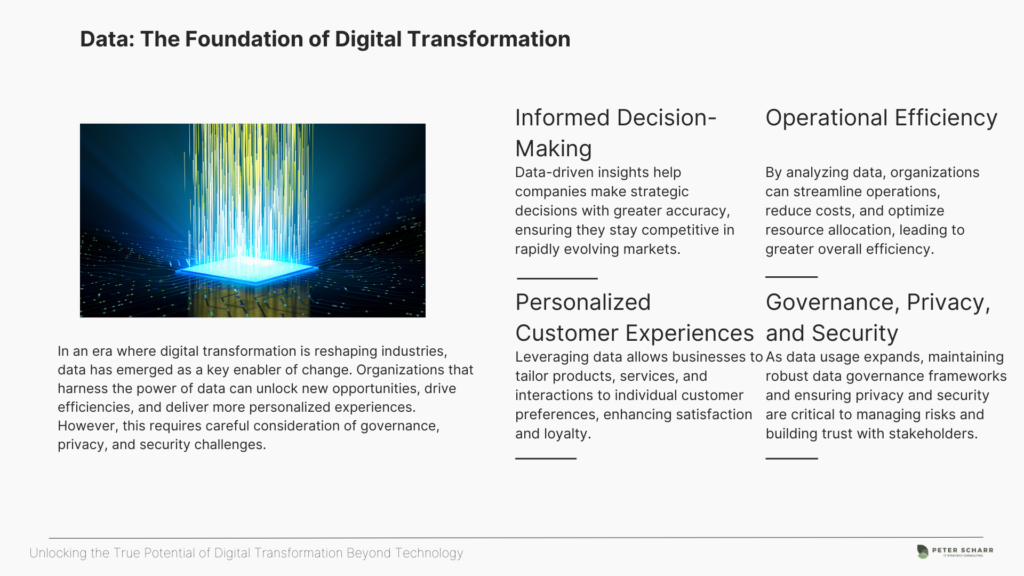Understanding Digital Transformation: More Than Just Technology
When most people think about digital transformation, they often picture cutting-edge tools, AI-driven systems, or automation processes. But here’s the truth: it’s so much more than just technology. While technology is an essential driver, it’s only one piece of a much larger puzzle. True digital transformation involves deep changes across how a company operates, engages with customers, and thinks about its future. It’s about fostering a culture that’s adaptable, efficient, and always ready to evolve.
Let’s break it down. A successful digital transformation touches three core areas: organizational culture, operational processes, and customer experiences. These areas work together to propel a company forward, but if any one of them is neglected, the transformation can fall flat. Just implementing the latest tech won’t make a meaningful difference if the organization’s culture can’t embrace it, or if processes remain stuck in the past.
Culture Shift: Adapting to Change
At the heart of any digital transformation is a shift in mindset. Organizations often need to break away from long-standing practices and adopt a more flexible, innovative approach. This means fostering a culture where employees are encouraged to experiment, fail fast, and learn faster. Companies like Lego and Microsoft have thrived by emphasizing adaptability and continuous learning among their teams.

However, changing a company’s culture is no easy feat. It requires clear communication, leadership buy-in, and a genuine commitment to support employees throughout the transition. Leaders must walk the talk and demonstrate how digital initiatives align with the company’s overall strategy. Without this alignment, employees may feel disconnected or even resist the transformation.
Operational Processes: Streamlining for Efficiency
Equally important are the day-to-day processes that keep the company running. One of the key goals of digital transformation is to streamline these processes, making them more efficient and less prone to human error. This could mean redesigning workflows, adopting automation tools, or even rethinking entire business models.
For example, Amazon revolutionized its supply chain by integrating advanced data analytics and machine learning. This allowed the company to not only predict customer demand but also optimize inventory management, cutting down delivery times and reducing costs. But as we’ve seen with Amazon, the technology itself wasn’t the full story—it was the way they rethought their processes to make the most of the technology.
Customer Experience: Meeting Evolving Expectations
Finally, no digital transformation is complete without considering the customer. Today’s customers expect seamless, personalized experiences. They want companies to anticipate their needs, offer convenience, and provide value in every interaction. Digital transformation allows businesses to meet—and even exceed—these expectations by leveraging data, improving service delivery, and offering new ways to engage.
Take Netflix, for instance. Its recommendation engine, powered by advanced algorithms, keeps viewers engaged by suggesting content they’re likely to enjoy. This personalized experience has been a massive part of Netflix’s success, as it keeps users coming back for more. But again, the algorithm is just the tool—the real transformation is in how Netflix has redefined the way we consume entertainment.
So, while technology is central to digital transformation, it’s the holistic integration of culture, processes, and customer focus that truly unlocks a company’s potential. The key is to ensure that all digital initiatives are aligned with the overarching business strategy, as explained earlier. When these elements are in sync, digital transformation becomes more than just an upgrade—it becomes a long-term competitive advantage.
The Role of Data – Powering Informed Decisions and Personalization
As we’ve covered earlier, digital transformation is much more than just adopting new technology. One essential element that ties everything together is data. Data plays a pivotal role, not only in shaping internal processes but also in how companies interact with their customers. It’s the fuel that powers informed decision-making, drives personalization, and unlocks new efficiencies. Without the smart use of data, even the most advanced technologies can fall short of their potential.
Let’s dive deeper into how companies can leverage data to thrive in their digital transformation journey.
Making Smarter Decisions with Data
Data provides the insights needed to make better, faster decisions. Instead of relying on guesswork or gut feelings, data empowers leaders and teams to act based on real evidence. The use of data analytics, for example, allows businesses to track customer behaviors, market trends, and operational performance in real time. This is why companies like IBM and Google have integrated data deeply into their decision-making processes, enabling them to stay ahead of the curve.
Imagine you’re a retail company trying to decide which products to stock for the upcoming season. In the past, you might have relied on historical sales or industry reports. But with access to live data, you can now predict trends, monitor social media conversations, and even adjust your inventory in real time based on emerging customer preferences. This ability to pivot quickly leads to more accurate decisions that can significantly impact both revenue and customer satisfaction.
Personalizing Customer Experiences
As mentioned earlier, today’s customers crave personalized experiences. And what makes personalization possible? You guessed it—data. By analyzing customer data, businesses can tailor their offerings, services, and communications to meet individual needs. This is where companies like Starbucks have excelled. Through their loyalty program and mobile app, they collect vast amounts of data, which they use to provide personalized recommendations, offers, and promotions to individual customers. The result? A more engaged and loyal customer base.
But the benefits don’t stop there. Personalization also improves customer retention. When customers feel understood, they’re more likely to stick with your brand. This is why data-driven personalization isn’t just a “nice-to-have” anymore—it’s a competitive necessity in today’s digital landscape.
Driving Operational Efficiencies
Data isn’t just for making smarter decisions or delighting customers. It’s also a powerful tool for improving internal processes. From supply chain management to staff scheduling, every aspect of a company’s operations can benefit from data-driven insights. Take the example of McKinsey’s analysis of data-driven supply chains. Companies that harness data can optimize everything from where to source materials to how to distribute products, reducing waste, improving delivery times, and cutting costs.
For instance, predictive analytics can help manufacturers determine when equipment is likely to fail, allowing them to perform maintenance before major issues arise. This approach, known as predictive maintenance, reduces downtime and saves on repair costs. In this way, data enhances operational efficiency by allowing companies to operate proactively instead of reactively.
Data Governance: Balancing Innovation with Responsibility
While the potential of data is immense, it comes with its own set of challenges—namely, issues around data governance, privacy, and security. As companies become more data-driven, they must also take responsibility for how that data is collected, stored, and used. Failing to do so can lead to not just legal penalties but also a loss of customer trust.
That’s why implementing strong data governance policies is crucial. This includes ensuring that data is accurate, accessible to the right people, and compliant with regulations like GDPR or CCPA. Additionally, companies must take steps to protect their data against cyber threats, as breaches can have disastrous consequences.
By addressing these concerns head-on, businesses can strike the right balance between leveraging the power of data and protecting the privacy and security of their customers. In doing so, they ensure that data remains a valuable asset in their digital transformation, rather than a potential liability.
Ultimately, data is the backbone of any successful digital transformation. As we’ve seen, it empowers smarter decision-making, improves customer experiences, and drives operational efficiencies. However, it’s important to manage data responsibly, ensuring that innovation doesn’t come at the cost of security or trust. With the right approach to data, companies can unlock the true potential of their digital transformation efforts and stay ahead in a rapidly evolving digital landscape.
Human-Centered Approaches to Digital Change – Empowering People, Not Just Systems
As we’ve discussed in the previous sections, digital transformation is about more than just technology. And while data, processes, and customer experiences are all critical, there is one key element that can’t be overlooked: people. No matter how advanced the technology, a digital transformation will only be successful if the workforce is empowered to embrace it. This means fostering a culture of continuous learning, equipping employees with the right tools, and ensuring that leadership is actively engaged in driving change.
The Importance of Training and Upskilling
One of the biggest challenges companies face during digital transformation is preparing their workforce for new tools and methodologies. Many employees may feel overwhelmed or even fearful about the changes ahead. This is where training and upskilling come in. By providing comprehensive training programs, businesses can ensure that employees are not only comfortable with new technologies but also able to leverage them effectively in their day-to-day tasks.
For instance, companies like AT&T have implemented large-scale reskilling programs to prepare their workforce for the digital era. Their “Future Ready” initiative includes online courses, mentorship, and formal training to help employees acquire new skills in areas like data analytics and cloud computing. This strategy not only boosts employee engagement but also increases the company’s ability to innovate and stay competitive in a rapidly evolving market. You can read more about this approach in a Forbes article on AT&T’s digital transformation journey.
Leadership: Guiding the Way
It’s not just employees who need to adapt—leadership plays a critical role in steering the ship through a successful digital transformation. Leaders must set the tone for the entire process, promoting an open mindset and showing that the transformation is about long-term growth, not just short-term technological upgrades. According to a Harvard Business Review article, leaders who embrace discomfort and guide their teams through uncertainty are more likely to foster innovation and resilience.
Moreover, leadership should actively participate in the transformation, demonstrating how new digital initiatives align with the company’s broader goals. This requires transparency, regular communication, and an openness to feedback. When employees see leadership genuinely invested in the process, they’re more likely to buy into the change themselves.
Building a Culture of Continuous Learning
In the fast-paced world of digital transformation, businesses can’t afford to stop learning. A one-time training session won’t cut it. Instead, companies need to foster a culture where continuous learning is not just encouraged—it’s expected. This means creating an environment where experimenting with new tools, processes, and ideas is part of the daily routine.
Companies like Google are a prime example of how a learning culture can drive innovation. Google’s “20% time” policy allows employees to spend 20% of their workweek exploring projects outside their regular job responsibilities. This approach has not only led to the creation of successful products like Gmail but has also empowered employees to continually learn and grow. When employees are encouraged to take risks and learn from their mistakes, they’re more likely to contribute meaningfully to the company’s digital transformation efforts.
Fostering Psychological Safety
Lastly, it’s essential to create an atmosphere of psychological safety within the workforce. Employees should feel comfortable voicing their concerns, sharing their ideas, and even making mistakes without fear of judgment. When people know they are supported, they’re more likely to take the necessary risks that drive innovation. This cultural shift, as we discussed in the earlier section on organizational culture, is a crucial component of successful digital transformation.
In conclusion, while technology is the vehicle for digital transformation, people are the drivers. By investing in training, supporting leadership, and fostering a culture of continuous learning, companies can empower their workforce to fully embrace the changes ahead. After all, the best tools in the world are only as powerful as the people using them.
And with that, you’re one step closer to unlocking the true potential of digital transformation,


